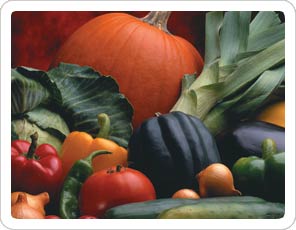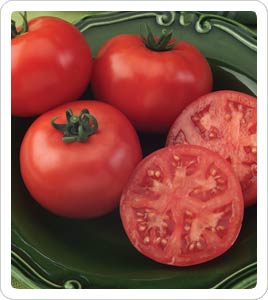|
What's not to love about a garden filled with edible fruits and vegetables?

You can grow your very own "edible garden" in a number of ways - from dedicated vegetable gardens to mixing herbs and veggies with your flowerbeds, to containers, trellises or raised beds of culinary delights.
Planning for an edible garden doesn't really require anything different from bedding plants - the important thing to think about is the harvest. Plus, you can plant in successions, so when one batch of veggies is done producing, another is ready to harvest.
The first thing you should do is figure out where you're going to put your edible garden. Most vegetables and herbs like full sun and the right soil is crucial. Generally, a slightly acidic soil with a pH of 6.0 to 6.8 will be beneficial to most veggies. Good drainage is essential, regardless of whether you're planting in containers or in the ground. If you find you're having problems, raised beds will drastically improved soil drainage.
Most veggies and herbs adapt well to container gardening, allowing apartment dwellers to create a small edible garden...
- You can use anything from wood and plastic to clay and ceramic.
- Standard 6 to 10-in. (15 to 25-cm) containers work well for green onions, herbs or lettuce as long as they're at least 8 in. (20 cm) deep.
- For tomatoes, peppers or runner beans, use larger containers. These plants need more space.
- If you grow your vegetables from seed, start them indoors first, then transplant them in your containers outdoors.
- Try to transplant your seedlings outdoors when a plant has its first two or three true leaves.
If space is an issue or if you want some vertical elements in your garden, use a trellis...
- You can do more than just runner beans. Vine crops like squash, pumpkins, melons and cucumbers can grow vertically with a little help.
- Try putting up your trellis at a slight angle to help coax the vines to grow up.
- You may need to tie some vines to the trellis and with heavier fruits - like melons - you can use slings attached to the trellis to help support their weight as they mature.
Raised beds are a great solution for culinary gardening...
- Not only do raised beds allow you to bring in good soil, but they provide superior drainage and cut down on weeds.

- Put the garden at a height where it's easier for many people to work on it if you are lucky enough to have a few helpers.
The lines of flower and vegetable gardening have blurred in recent years, so it's not uncommon to see lettuce or Swiss chard mixed in with annuals...
- Tomatoes can act as a colorful accent to a flower garden in late Summer.
- For a great height element in Autumn, use sweetcorn in your flowerbeds.
- There aren't really any rules when it comes to mixing and matching, however, it's important to only use products that are labeled safe for use with vegetables.
When to plant fruits and vegetables...
- Like flowers, there are cool-loving and heat-loving vegetables and herbs.
- Cool-loving crops can be planted in early Spring - sometimes even before the last frost. Examples of cool-loving vegetables are peas, broccoli, spinach, Brussels spouts, cabbage, garlic, kale, leeks, lettuce, onions and Swiss chard.
- Plant heat-loving vegetables around the cool-loving ones so you can continue to harvest throughout the growing season (called successive planting). Examples of these types of plants are tomatoes, cucumbers and squash.
- If you plant cool and heat-loving vegetables and fruits together, be sure you cultivate the soil between the crops. A slow-release fertilizer works best with successive planting.
If you have any additional questions about growing vegetables, fruits and herbs, contact your local garden centre.
|